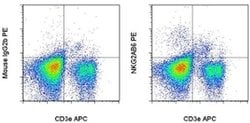Learn More
Invitrogen™ NKG2AB6 Monoclonal Antibody (16a11), PE, eBioscience™
Mouse Monoclonal Antibody
Supplier: Invitrogen™ 12589781

Description
Description: The 16a11 monoclonal antibody reacts with the mouse NKG2A^B6. NKG2 molecules belong to a C-type lectin-like family of cell surface receptors expressed by mouse NK and NKT cell lineages. NKG2 molecules form heterodimeric complexes with CD95 and are responsible for recognition of non-classical MHC class I antigen Qa-1. This antibody reacts with the C57Bl/6 mouse strain, but does not react with the BALB/c or 129 mouse strains. When co-staining with NKG2A/C/E clone 20d5, it is important to stain for NKG2A^B6 first then subsequently with NKG2A/C/E, as steric hindrance has been observed if co-stained concurrently. Applications Reported: 16a11 has been reported for use in flow cytometric analysis. Applications Tested: The 16a11 antibody has been tested by flow cytometric analysis of C57Bl/6 (positive control) and BALB/c (negative control) mouse splenocytes and can be used at less than or equal to 1 μg per test. A test is defined as the amount (μg) of antibody that will stain a cell sample in a final volume of 100 μL. Cell number should be determined empirically but can range from 10^5 to 10^8 cells/test. It is recommended that the antibody be carefully titrated for optimal performance in the assay of interest. Excitation: 488-561 nm; Emission: 578 nm; Laser: Blue Laser, Green Laser, Yellow-Green Laser. Filtration: 0.2 μm post-manufacturing filtered.
Natural killer (NK) cells are lymphocytes that can mediate lysis of certain tumor cells and virus-infected cells without previous activation. They can also regulate specific humoral and cell-mediated immunity. The protein encoded by this gene belongs to the killer cell lectin-like receptor family, also called NKG2 family, which is a group of transmembrane proteins preferentially expressed in NK cells. This family of proteins is characterized by the type II membrane orientation and the presence of a C-type lectin domain. This protein forms a complex with another family member, KLRD1/CD94, and has been implicated in the recognition of the MHC class I HLA-E molecules in NK cells. The genes of NKG2 family members form a killer cell lectin-like receptor gene cluster on chromosome 12. Four alternatively spliced transcript variants encoding two distinct isoforms have been observed.
Specifications
| NKG2AB6 | |
| Monoclonal | |
| 0.2 mg/mL | |
| PBS with 0.09% sodium azide; pH 7.2 | |
| 0 | |
| Klrc1 | |
| Affinity chromatography | |
| RUO | |
| 16641 | |
| 4°C, store in dark, DO NOT FREEZE! | |
| Liquid |
| Flow Cytometry | |
| 16a11 | |
| PE | |
| Klrc1 | |
| CD159 antigen-like family member A; CD159A; C-lectin type II protein; Cluster of Differentiation 159a; killer cell lectin like receptor C1; killer cell lectin-like receptor subfamily C, member 1; Klrc1; natural killer cell lectin; natural killer group protein 2; NK cell receptor A; NKG2; NKG2-1/B activating NK receptor; NKG2A; NKG2-A/B type II integral membrane protein; NKG2-A/B-activating NK receptor; NKG2-A/NKG2-B type II integral membrane protein; NKG2B; rNKG2A | |
| Mouse | |
| 50 μg | |
| Primary | |
| Mouse | |
| Antibody | |
| IgG2b κ |
The Fisher Scientific Encompass Program offers items which are not part of our distribution portfolio. These products typically do not have pictures or detailed descriptions. However, we are committed to improving your shopping experience. Please use the form below to provide feedback related to the content on this product.

